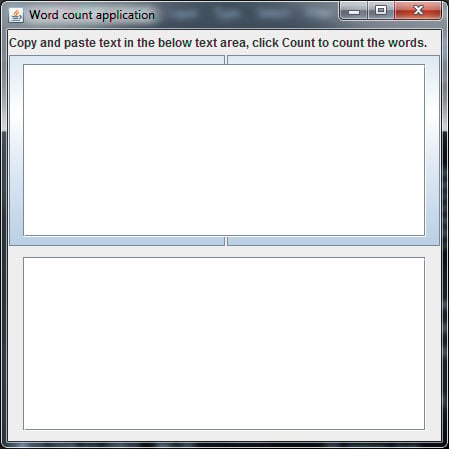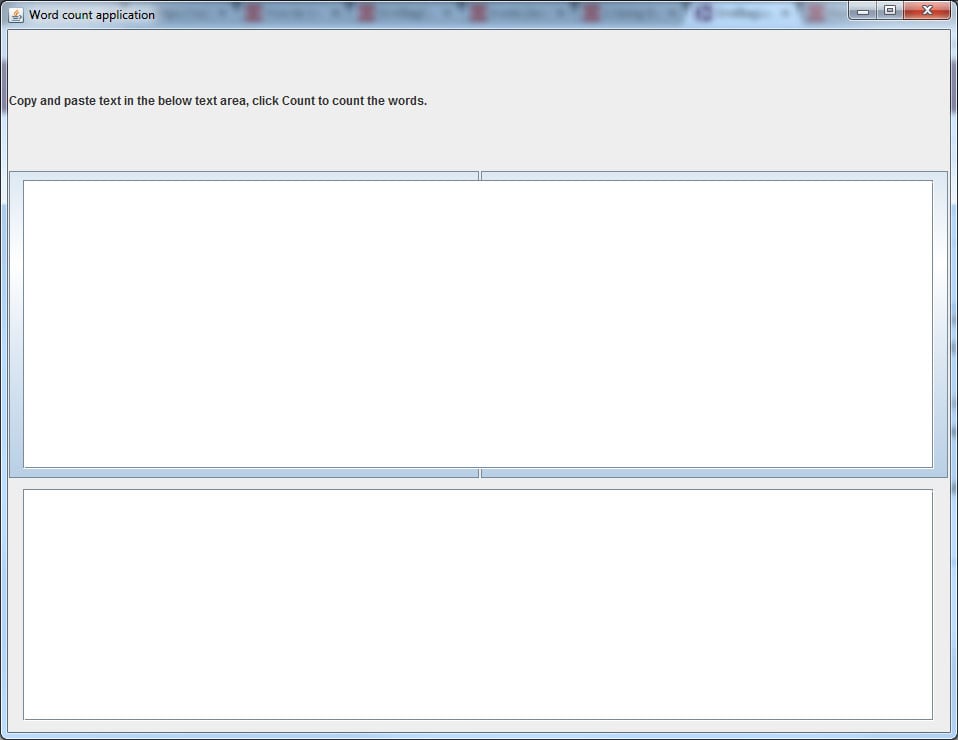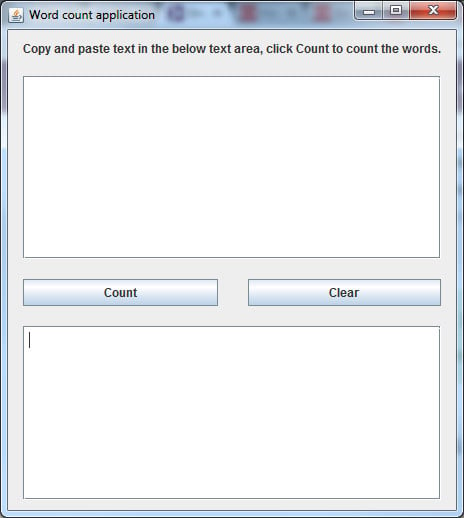HI guys, as mentioned in my revious post, I'll redo my wordCount application using the GridBagLayout approach. The functionality of the application hasn't changed at all: I've only removed the various Jpanels and, for simplicity, used only the JFrame and attached all the comonents to the JFrame.
I've had a look around to see how the GridBagLayout works etc, and even if I've seen slightly different approaches, I went for the most concise of them all where I create the component, add it to the panel using this constructor (found here https://docs.oracle.com/javase/8/docs/api/java/awt/GridBagConstraints.html)
GridBagConstraints(int gridx, int gridy, int gridwidth, int gridheight, double weightx, double weighty, int anchor, int fill, Insets insets, int ipadx, int ipady)
I started with photoshop first, drawing roughly how I'd like the application to look like: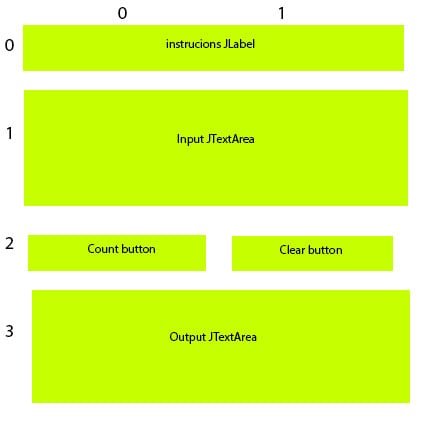
So I began to position my components in a 4x2 grid, but I run into problems, and quite a few. Here is the code that sets the constraints:
add(instructions, new GridBagConstraints(0,0,2,1,0,1.0,CENTER,BOTH, new Insets(1,1,1,1),1,1));//adding instruction jlabel and constraints
add(new JScrollPane(textInput), new GridBagConstraints(0,1,2,2,1.0,1.0,CENTER,BOTH,new Insets(1,1,1,1),1,1));//adding textInput and constraints
add(processButton, new GridBagConstraints(0,2,1,2,0,0,CENTER,BOTH,new Insets(1,1,1,1),1,1));//adding processButton and constraints
add(clearButton, new GridBagConstraints(1,2,1,2,0,0,CENTER,BOTH,new Insets(1,1,1,1),1,1));//adding clearButton and constraints
add(new JScrollPane(textOutput), new GridBagConstraints(0,3,2,3,1.0,1.0,CENTER,BOTH,new Insets(1,1,1,1),1,1));//adding textOutput
Somehow, only the JLabel and the two JTextAreas are visible, the two buttons aren't there. This is how it looks like: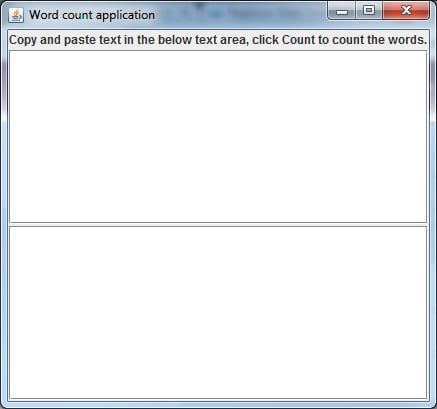
The code seems to me to be OK, in the sense that I've positioned the buttons one next to the other (pos 0,2 and 1,2) and centered them, but they don't appear.
Also, equally annoying, the java window doesn't seem to be the size I want it to be: I specified wordCount.setSize(900,800); but it doesn't look anywhere near that size, much smaller in fact, and I'm wondering where it is getting its size from...
Here is the code:
/*WordCount.java
Application determines how many times a word has occurred in the text given
*/
import javax.swing.JFrame;
import javax.swing.JLabel;
import javax.swing.JTextArea;
import javax.swing.JButton;
import javax.swing.JScrollPane;
import java.awt.GridBagLayout;
import java.awt.GridBagConstraints;
import static java.awt.GridBagConstraints.*;
import java.awt.Insets;
import java.awt.Color;
import java.awt.event.ActionEvent;
import java.awt.event.ActionListener;
import java.util.Map;
import java.util.HashMap;
import java.util.Set;
import java.util.TreeSet;
import java.util.StringTokenizer;
public class WordCount extends JFrame{
private JTextArea textInput;
private JTextArea textOutput;
private JButton processButton;
private JButton clearButton;
private JLabel instructions;
private GridBagLayout gbLayout;
/* private GridBagConstraints inputConstraints;//declare constraints input textAea
private GridBagConstraints outputConstraints;//declare constraints output textArea
private GridBagConstraints CountConstraints;//declare constraints count button
private GridBagConstraints ClearConstraints;//declare constraints clear button
private GridBagConstraints instructionsConstraints;//declare constraints JLabel */
private String stringToTest;//holds string pasted in textarea
private String[] tokens;//array of tokenized strings
Map<String,Integer> mp = new HashMap<String, Integer>();//declaring a map object
public WordCount(){
super("Word count application");
gbLayout = new GridBagLayout();//create new GBL object
setLayout(gbLayout);//set JFrame GBL
textInput = new JTextArea(10,15);//holds the input text
textOutput = new JTextArea(10,15);//hold the output text
textOutput.setMargin(new Insets(5,5,5,5));//sets margins inside the element
textInput.setMargin(new Insets(5,5,5,5));//sets margins inside the element
stringToTest = "";//initialize to empty string
processButton = new JButton("Count");//action abutton
clearButton = new JButton("Clear");//to clear textArea
instructions = new JLabel("Copy and paste text in the below text area, click Count to count the words.\n");//holding instructions
textInput.setText("");//initialize to empty string
textOutput.setText("");//initialize to empty string
add(instructions, new GridBagConstraints(0,0,2,1,0,1.0,CENTER,BOTH, new Insets(1,1,1,1),1,1));//adding instruction jlabel and constraints
add(new JScrollPane(textInput), new GridBagConstraints(0,1,2,2,1.0,1.0,CENTER,BOTH,new Insets(1,1,1,1),1,1));//adding textInput and constraints
add(processButton, new GridBagConstraints(0,2,1,2,0,0,CENTER,BOTH,new Insets(1,1,1,1),1,1));//adding processButton and constraints
add(clearButton, new GridBagConstraints(1,2,1,2,0,0,CENTER,BOTH,new Insets(1,1,1,1),1,1));//adding clearButton and constraints
add(new JScrollPane(textOutput), new GridBagConstraints(0,3,2,3,1.0,1.0,CENTER,BOTH,new Insets(1,1,1,1),1,1));//adding textOutput
textOutput.setMargin(new Insets(5,5,5,5));//sets margins inside the element
textInput.setMargin(new Insets(5,5,5,5));//sets margins inside the element
ProcessButtonHandling handler1 = new ProcessButtonHandling();
ClearButtonHandling handler2 = new ClearButtonHandling();
processButton.addActionListener(handler1);
clearButton.addActionListener(handler2);
}//end of constructor
public String getString(){
return stringToTest;
}
//inner class for event handlings
private class ProcessButtonHandling implements ActionListener{
public void actionPerformed(ActionEvent event){
stringToTest = textInput.getText();
processString(getString());//call function to split string
mapWords();//count words and place results in the hashmap
printMap();//print the map values and keys in the textArea
}//end of actionPerformed
}//end of inner class
private class ClearButtonHandling implements ActionListener{
public void actionPerformed(ActionEvent event){
textOutput.setText("");
textInput.setText("");
}//end of actionPerformed
}//end of inner class
public void processString(String testingString){
//String[] tokens = testingString.split("(?=[,.])|\\s+");
testingString = testingString.replaceAll("[,.;:]","");//remove the characters in brackets and replace them with nothing
tokens = testingString.split(" ");//split string using space as delimiter
/* System.out.printf("Number of elements: %d\nTokens are \n", tokens.length);
//print to test
for(String token : tokens){
System.out.println(token);
} */
}
public void mapWords(){
for(int i = 0; i < tokens.length; i++){
if(mp.containsKey(tokens[i])){
//increment Integer
mp.put(tokens[i], mp.get(tokens[i]) + 1);//add it to the hashmap and increment integer
}
else{
mp.put(tokens[i],1);//add it to the hashmap
}
}
}
public void printMap(){
for(Map.Entry<String, Integer> entry : mp.entrySet()){//loop thru map to print data
//System.out.println("Key = " + entry.getKey() + ", Value = " + entry.getValue());
textOutput.append("Key = " + entry.getKey() + ",\t Value = " + entry.getValue() + "\n");
System.out.println("Key = " + entry.getKey() + ",\t Value = " + entry.getValue()+ "\n");//for debug purposes
}
}
}//end of WordCount
/*WordCountTest.java
WordCountTest to test the class
*/
import javax.swing.JFrame;
public class WordCountTest{
public static void main(String[] args){
WordCount wordCount = new WordCount();
wordCount.setDefaultCloseOperation(JFrame.EXIT_ON_CLOSE);
wordCount.setSize(900,800);
wordCount.pack();
wordCount.setVisible(true);
}//end of main
}//end of WordCountTest
